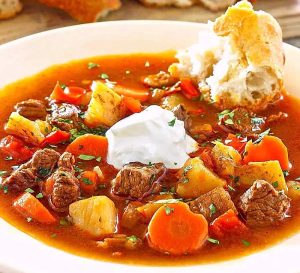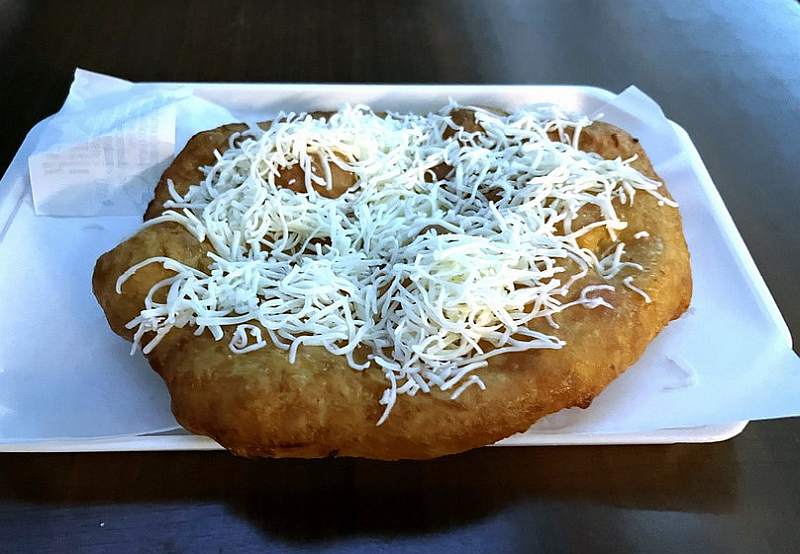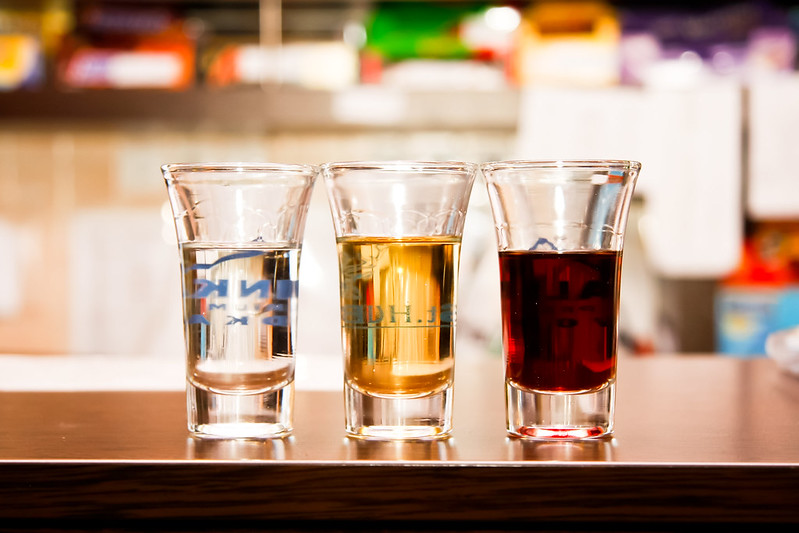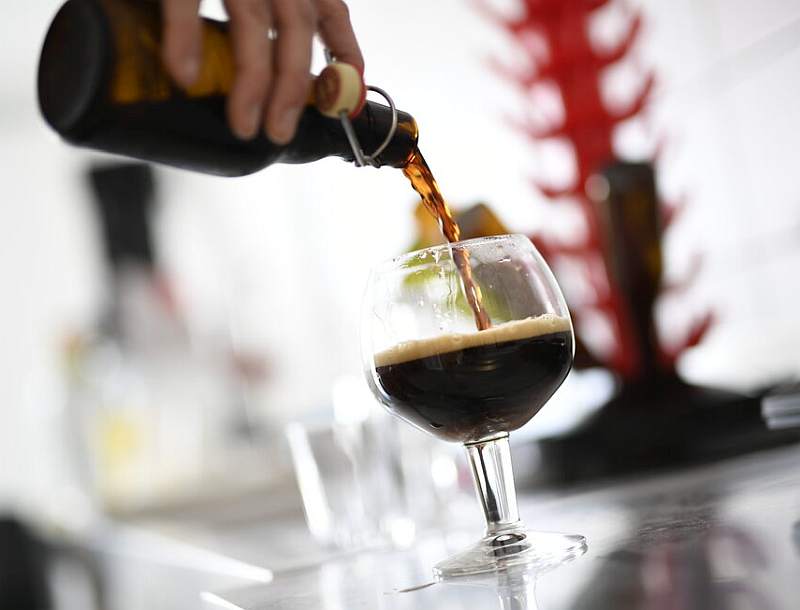A culinary journey through the gastronomic delights of Budapest
Budapest is a city of rich history and vibrant culture, and this is reflected in its diverse and flavorful cuisine. From hearty traditional dishes to modern culinary innovations, there’s something to tantalize every palate. Here are some food and drink recommendations for your journey through the gastronomic landscape of Budapest:
Goulash: A Culinary Journey Through Hungary
When you embark on a culinary journey through Hungary, there’s one dish that stands as a symbol of the country’s rich history and cultural tapestry: Goulash. This isn’t just any stew; it’s a tale of nomadic tribes, pastoral celebrations, and the essence of Hungarian soul food.

Origins: Originating from the 9th-century Magyar shepherds of the Carpathian Basin, the early form of goulash was a simple dish. These shepherds would slow-cook diced meat with onions in heavy iron pots over open fires until tender. Once cooked, they’d dry the contents in the sun, creating portable food. When they wanted to eat, they’d simply add water to the dried mix and heat it up.
Evolution: Over the centuries, as new ingredients became available, goulash evolved. The most significant addition was the paprika, introduced to Hungary in the 16th century by the Turks. This vibrant red spice, derived from ground peppers, added a unique warmth and depth to the dish, making it distinctively Hungarian.
The Dish Today: Today, goulash is a rich, hearty stew made primarily of beef (though other meats can be used), onions, bell peppers, tomatoes, potatoes, and a generous amount of paprika. It’s often spiced with caraway seeds and garnished with fresh parsley. The flavors meld together, creating a comforting dish that warms the soul and fills the belly.
How to Enjoy: Goulash can be enjoyed as a main dish or as a soup, depending on its consistency. It’s traditionally served with Hungarian egg noodles called “nokedli,” but crusty bread or potatoes are equally satisfying accompaniments. A dollop of sour cream on top enhances its richness.
Beyond Borders: Goulash’s influence has spread beyond Hungary’s borders. Variations can be found in neighboring countries, each putting its unique spin on the classic.
When in Hungary or anywhere offering Hungarian cuisine, missing out on goulash would be akin to visiting Italy and skipping pasta, so, pull up a chair, grab a hearty bowl, and indulge in a dish that’s not just food but a flavorful journey through the annals of Hungarian history.
Chicken Paprikash: A Dive into Hungary’s Spicy Heritage
In the heart of Central Europe, the Hungarian culinary landscape tells a tale of history, passion, and innovation. And at the center of this gastronomic storytelling is the nation’s favorite spice – paprika. One dish, in particular, showcases this vibrant red seasoning in all its glory: Chicken Paprikash.

Historical Roots: Hungary’s love affair with paprika dates back to the 16th century when the spice was introduced by the Ottoman Turks. Over time, this humble pepper was embraced, cultivated, and eventually became the backbone of numerous Hungarian recipes. Chicken Paprikash, or “Paprikás Csirke” as locals call it, is one of the most beloved results of this union.
The Dish Unveiled: The beauty of Chicken Paprikash lies in its simplicity. At its core, it’s a harmony of tender chicken pieces simmered in a luscious sauce made from sautéed onions, generous heaps of paprika, and often a touch of tomato paste or bell peppers. The sauce’s magic happens as it’s thickened with sour cream, producing a creamy, velvety texture that’s rich in flavor.
Serving Traditions: While the dish is a star on its own, its customary companions elevate it to new culinary heights. Traditionally, Chicken Paprikash is served with “nokedli” – soft, pillowy Hungarian dumplings that absorb the sauce beautifully. Alternatively, a side of tangy pickled vegetables or a fresh cucumber salad complements the richness of the dish.
Variations: Just as each Hungarian household has its unique traditions, variations of Chicken Paprikash exist. Some add a splash of white wine for depth, while others might incorporate bell peppers or tomatoes for a slightly tangier taste.
A Culinary Journey: To taste chicken paprikash means to embrace Hungarian culture. It’s a dish that speaks of family gatherings, long-standing traditions passed down through generations and the warmth and hospitality that Hungarians are renowned for.
When you find yourself at a Hungarian table, with the aroma of Chicken Paprikash wafting through the air, you’re not just about to enjoy a meal. You’re about to embark on a culinary journey that captures the essence of Hungary, one flavorful bite at a time.
Lángos: Hungary’s Favorite Street Food Delight
A Flavorful Introduction: Picture yourself wandering through the bustling streets of Budapest when suddenly, the tantalizing aroma of freshly fried dough wafts towards you. That irresistible scent, my friend, is the hallmark of Hungary’s cherished street food: Lángos.
Origins and Tradition: The history of Lángos goes back centuries, its name stemming from ‘láng’, the Hungarian word for flame. Originally baked in brick ovens close to the flames, it transitioned over time into the deep-fried delicacy we adore today. While Lángos’ roots might be debated – some say it came with the Turks during the Ottoman Empire, others believe it has been a part of Hungarian culture for longer – its status as a beloved snack is undisputed.

Crafting the Perfect Lángos: At its heart, Lángos is simple: a dough made of water, flour, yeast, and salt. Yet, the magic is in its preparation. The dough is deep-fried to perfection, resulting in a crispy golden exterior and a soft, fluffy inside. The sensation of biting into a hot Lángos, fresh out of the fryer, is a culinary experience like no other.
Toppings Galore: While the plain Lángos is delightful, the toppings elevate it to legendary status. The classic topping combo is a generous smear of sour cream crowned with a mountain of grated cheese. However, the versatility of Lángos means that its topping possibilities are endless. From garlic oil and butter to more hearty toppings like ham, sausage, or even veggies – everyone has their personal favorite Lángos style.
Lángos Across Borders: Lángos’ appeal isn’t confined to Hungary. Its popularity has spread across Central Europe, and each region has added its twist, introducing a delightful variety of toppings and preparation styles.
Enjoying Lángos Like a Local: For an authentic experience, grab a Lángos from a street vendor or a local market while in Budapest. Pair it with a cold Hungarian soda or beer, and you’ve got yourself a perfect, filling snack. Be prepared, though – it’s hard to stop at just one!
In the end, while Hungary offers a vast palette of culinary treasures, there’s nothing quite like the simple pleasure of a freshly made Lángos. So, the next time you find yourself in this beautiful country, remember: a trip is incomplete without indulging in this deep-fried wonder!
Kürtőskalács: Hungary’s Sweet Spiral Delight
A Tantalizing Introduction: As you stroll through the charming streets of Budapest, it’s hard to miss the spiral-shaped sweet delight that has become synonymous with Hungarian street food: the Kürtőskalács, or the chimney cake as it’s fondly called by tourists. Its sweet aroma, crispy exterior, and soft inner layers make it an irresistible treat for anyone with a sweet tooth.
A Glimpse into its History: With origins tracing back to Transylvania, Kürtőskalács is believed to have been a staple in Hungarian celebrations for centuries. Its name is derived from the Hungarian words ‘kürtő’, meaning chimney or flue, and ‘kalács’, which means bread or cake, reflecting its distinctive shape and method of preparation.

Crafting the Iconic Kürtőskalács: The process of making this delicacy is both an art and a spectacle. The dough is handmade, carefully spun, and then wrapped around a cone-shaped baking spit. Once wrapped, it’s generously coated with granulated sugar and put to roast over charcoal. As the cake rotates, the sugar caramelizes, forming a shiny, crispy crust that contrasts beautifully with the soft and fluffy interior.
Flavors and Varieties: While the traditional Kürtőskalács is covered with sugar, modern versions offer a variety of flavors to choose from. After roasting, the hot chimney cake can be further rolled in toppings such as cinnamon, walnut, coconut, cocoa, or even sprinkles. Some vendors have even introduced stuffed versions filled with chocolate, ice cream, or fruit preserves, adding a delightful twist to the classic.
Cultural Significance: Traditionally, Kürtőskalács was made during significant events or celebrations like weddings. It has become a year-round delicacy, particularly popular during Christmas markets and festivals.
Savoring the Experience: For the best Kürtőskalács experience, buy one fresh off the coals. The warmth of the cake, combined with its sweet aroma, is simply enchanting. Paired with a hot cup of cocoa or mulled wine, especially during the chilly months, it’s a match made in gastronomic heaven.
In Conclusion, Kürtőskalács is more than just a sweet treat; it’s a taste of Hungary’s rich cultural heritage and culinary traditions. So, whether you’re a first-time visitor or a returning traveler, indulging in a chimney cake is a must. Let its layers unravel to tell you a tale of Hungarian flavors and history with every bite.
Pálinka: The Fiery Spirit of Hungary
Introduction: When in Hungary, there’s one drink that stands tall amidst the country’s rich tapestry of beverages: Pálinka. This clear, powerful fruit brandy is not just a drink; it’s an emblem of Hungarian culture and tradition, a sip of which tells tales of ancient harvests, community gatherings, and warmth against the winter chill.
A Taste of History: The origins of Pálinka can be traced back to the Middle Ages. Over centuries, it evolved from a simple peasant’s drink to a refined spirit enjoyed by all echelons of Hungarian society. Today, it’s protected by the European Union, ensuring that only fruit brandies distilled in Hungary and made without additives can bear the name Pálinka.
Crafting Pálinka: Derived entirely from local fruits like apricots, pears, plums, cherries, and apples, Pálinka is made by fermenting the chosen fruit and then distilling the mash. The resulting spirit is then often aged in wooden casks to enhance its flavor. The beauty of Pálinka lies in its purity and the rich essence of the fruit it is made from.

Tasting Notes: Pálinka offers a robust aroma, hinting at the fruit from which it’s distilled. As it touches the palate, expect an explosion of flavors, ranging from the gentle sweetness of the fruit to the fiery kick of the alcohol. It leaves a warm, lingering finish, much like the afterglow of a memorable experience.
How to Enjoy Pálinka: Traditionally, Pálinka is consumed at room temperature to appreciate its full bouquet of flavors. It is often sipped before a meal as an appetizer or after as a digestif. While Pálinka is potent, its high alcohol content (often 40% or higher) is balanced by its fruit-forward taste.
A Word of Caution: Indeed, Pálinka is not for the faint-hearted. Its high alcohol content means it packs a punch. So, while it’s a delightful experience to savor this iconic Hungarian spirit, remember to enjoy it responsibly.
In Conclusion, Pálinka is more than just a drink. It’s a tribute to the Hungarian soil, its fruits, and its people’s enduring spirit. Embark on a sensory journey with Pálinka and embrace a taste that’s deeply rooted in the heart of Hungary. But, as always, proceed with a touch of caution; after all, it’s a fiery spirit in every sense of the word!
Wine Wonders of Hungary: A Journey Through Vineyards and Time
Introduction: Hungary, with its rich tapestry of history and fertile lands, has cultivated a unique winemaking tradition that spans over a millennium. Blessed with diverse climates and terroirs, Hungary’s wine regions yield a plethora of wines, each with its distinct taste and story. From the legendary sweet wines of Tokaj to the robust reds of Eger, the Hungarian wine landscape is as varied as it is rich.
Tokaji: The Wine of Kings: Tokaji, or Tokay, as it’s often called, hails from the Tokaj wine region located in northeastern Hungary. With a history stretching back to the 12th century, Tokaji has often been referred to as the “Wine of Kings, King of Wines”. Made predominantly from the Furmint and Hárslevelű grapes, it’s known for its lusciously sweet Aszú wines. These wines are produced from grapes affected by noble rot, which concentrates their sugars and flavors, resulting in a sweet and vibrant wine with refreshing acidity. Tokaji wines are renowned for their complexity and can age for decades if not centuries.

Egri Bikavér (Bull’s Blood of Eger): Originating from the Eger wine region in the north, Egri Bikavér, colloquially known as Bull’s Blood, is a robust red blend that historically comprises at least three grape varieties. Legend has it that the name “Bull’s Blood” derives from the 1552 Siege of Eger, where Hungarian soldiers drank this wine to boost their strength, leading the Ottomans to believe they were drinking bull’s blood to fortify themselves. This hearty wine is characterized by its dark color, full-bodied nature, and spicy notes.
Diverse Wine Regions, Diverse Wines: Beyond Tokaj and Eger, Hungary boasts 22 wine regions, each with its distinct terroir and wine style. Whether it’s the aromatic whites of Somló, the elegant reds of Villány, or the sparkling wines of Etyek-Buda, there’s a Hungarian wine to match every palate.
A Taste of Tradition: Hungarian winemaking is a blend of tradition and innovation. While many winemakers hold fast to time-honored techniques, there’s also a burgeoning movement towards organic and biodynamic winemaking, marrying the best of the old with the new.
Conclusion: though sometimes overshadowed by their European counterparts, Hungarian wines have a rich depth and variety that beckons to be explored. Each bottle tells a story of its region, its history, and its people. So, on your next wine adventure, venture into the vineyards of Hungary and raise a glass to centuries of winemaking excellence.
Craft Beers in Budapest: A Frothy Adventure
Introduction: Budapest, with its iconic bridges, thermal baths, and grand boulevards, has another claim to fame that’s bubbling under the surface – craft beer. Over the past decade, the Hungarian capital has embraced the craft beer movement with gusto, adding a modern and effervescent twist to the city’s drinking culture.
A City Embracing Change: Traditionally, Hungary was more known for its wines than beers. However, the winds of change blew, and the beer scene in Budapest began to shift. Passionate brewers, drawing inspiration from local traditions and international beer cultures, embarked on creating unique, flavor-packed beers that resonate with locals and visitors alike.

Variety is the Spice of Beer: From hop-packed IPAs to rich and roasty stouts, Budapest’s craft beer landscape is as diverse as the city itself. Want something light and refreshing? Try a session ale or a wheat beer infused with local fruits. Budapest’s craft breweries often experiment with barrel-aging for those looking for something bolder, creating deep, complex brews that challenge and delight the palate.
Where to Sample: The city is dotted with craft beer bars and taprooms, each boasting a selection showcasing the best Hungarian craft brewing. Some renowned spots include:
- Élesztő: Often credited as the torchbearer of Budapest’s craft beer revolution, Élesztő is a spacious beer garden and taproom with an impressive selection of both local and international beers.
- Neked Csak Dezső: A cozy spot with an extensive beer list. It’s the perfect place to explore the myriad flavors of Hungarian craft brews.
- Hopaholic: As the name suggests, this place is a haven for hop lovers. With a constantly rotating tap list, there’s always something new to try.
Festivals and Events: Budapest also hosts numerous beer festivals throughout the year, celebrating the city’s love for craft brews. Events like Budapest Beer Week offer beer enthusiasts an opportunity to sample a vast array of brews, attend workshops, and meet the masterminds behind their favorite beers.
Conclusion: Craft beer in Budapest is more than just a drink; it’s a journey of discovery. Each sip tells a story of creativity, passion, and innovation. So, next time you find yourself wandering the enchanting streets of Budapest, take a detour into one of its many craft beer bars and toast to the city’s effervescent spirit. Cheers!
Hungarian Strudels: A Culinary Embrace of Sweetness and Tradition
Introduction: Hungary’s rich culinary history brings us the delightful treat known as strudel (or ‘rétes’ in Hungarian). This pastry, which has its origins in the Austro-Hungarian empire, has been embraced and cherished by the Hungarians, adding their unique twist to it.
The Art of Strudel Making: The magic of a strudel lies in its thin, delicate, and flaky crust. Making it requires skill and tradition. The dough, made primarily from flour, water, and fat, is worked until elastic and then stretched painstakingly thin, often until it’s almost translucent. This ensures that, once baked, it becomes incredibly light and flaky.
Sweet Embraces: While strudels can be filled with a variety of ingredients, some stand out as classic Hungarian choices:
- Apple Strudel (Almás Rétes): This is perhaps the most popular type. The filling is a comforting mix of tart cooking apples, sugar, cinnamon, raisins, and sometimes breadcrumbs to soak up the juice. Once baked, the apple becomes soft and fragrant, contrasted beautifully by the crunchy pastry.
- Cherry Strudel (Meggyes Rétes): The sweet-tartness of cherries, often enhanced with a hint of almond or vanilla, makes this strudel a favorite during cherry season. The vibrant red filling peeking through the flaky layers is also a feast for the eyes.
- Cottage Cheese Strudel (Túrós Rétes): A richer variation, this strudel is filled with sweetened cottage cheese, often mixed with lemon zest, raisins, or even a dash of vanilla. It’s a creamy contrast to the crisp pastry and holds a special place in Hungarian festivities.
Savory Variants: While sweet strudels are more popular, savory versions also have their place in Hungarian cuisine. These might be filled with ingredients like cabbage, spinach, or pumpkin.

Serving and Enjoyment: Strudels are best enjoyed fresh from the oven, with a light dusting of powdered sugar for the sweet versions. They’re often served alongside a dollop of cream or a scoop of ice cream. Every bite of this layered pastry is a blend of textures and flavors, taking you on a journey through Hungarian traditions and culinary artistry.
Conclusion: So, when in Hungary, do as the Hungarians do: find a cozy café, order a slice of strudel and a coffee, and savor the craftsmanship and tradition in every flaky, delicious bite. Enjoy the warmth and sweetness of this age-old dessert that has stood the test of time.
Budapest’s Coffee Renaissance: A Journey Through Time and Taste
Introduction: The aroma of freshly brewed coffee wafts through the historic streets of Budapest, inviting visitors and locals alike to partake in a centuries-old ritual. Budapest’s coffee culture is not just about sipping a warm beverage; it’s a testament to the city’s rich history, resilience, and its zest for life.
A Rich Tradition: Historically, Budapest’s coffee houses weren’t just places to drink coffee. They were hubs of intellectual discussions, rendezvous points for writers and artists, and often the birthplaces of revolutionary ideas. Over the years, these coffee houses have retained their charm, becoming timeless symbols of the city’s cultural and intellectual fervor.
The Traditional Coffee Houses: Some of Budapest’s coffee houses have stood the test of time, serving patrons for well over a century. Establishments like the New York Café, Gerbeaud, and Ruszwurm offer not just delicious coffee but also a journey back in time. With their ornate interiors, gilded ceilings, and plush seating, these coffee houses transport you to the golden era of Budapest’s past.
A Culinary Delight: Alongside your coffee, treat yourself to the rich and varied pastries the city has to offer. Whether it’s the aforementioned strudels, creamy Dobos torte, or crispy, deep-fried chimney cakes, there’s a sweet delight waiting to be paired with your favorite brew.
Modern Coffee Culture: While the traditional coffee houses offer a taste of the past, Budapest’s modern coffee scene is vibrant and innovative. Artisanal coffee shops and roasteries dot the city, serving everything from perfectly poured espressos to cold brews and specialty lattes. These contemporary spots often blend the old with the new, creating spaces that are both cozy and chic.

The Community Aspect: One of the defining features of Budapest’s coffee culture is its emphasis on community. Coffee houses, both old and new, serve as meeting spots, workspaces, and even event venues. They foster connections, facilitate creativity, and provide solace in the midst of urban chaos.
Conclusion
As you wander the streets of Budapest, let the allure of its coffee culture guide you. Whether you choose the grandeur of a historic coffee house or the intimacy of a modern café, you’ll be partaking in a cherished Budapest tradition. So, order your favorite brew, pick a pastry, and immerse yourself in the ambiance of a city that celebrates life, one cup at a time.
Hungarian cuisine is all about comfort, flavor, and heartiness. So, whether you’re dining in an elegant restaurant, a local bistro, or a bustling food market, you’re in for a treat!